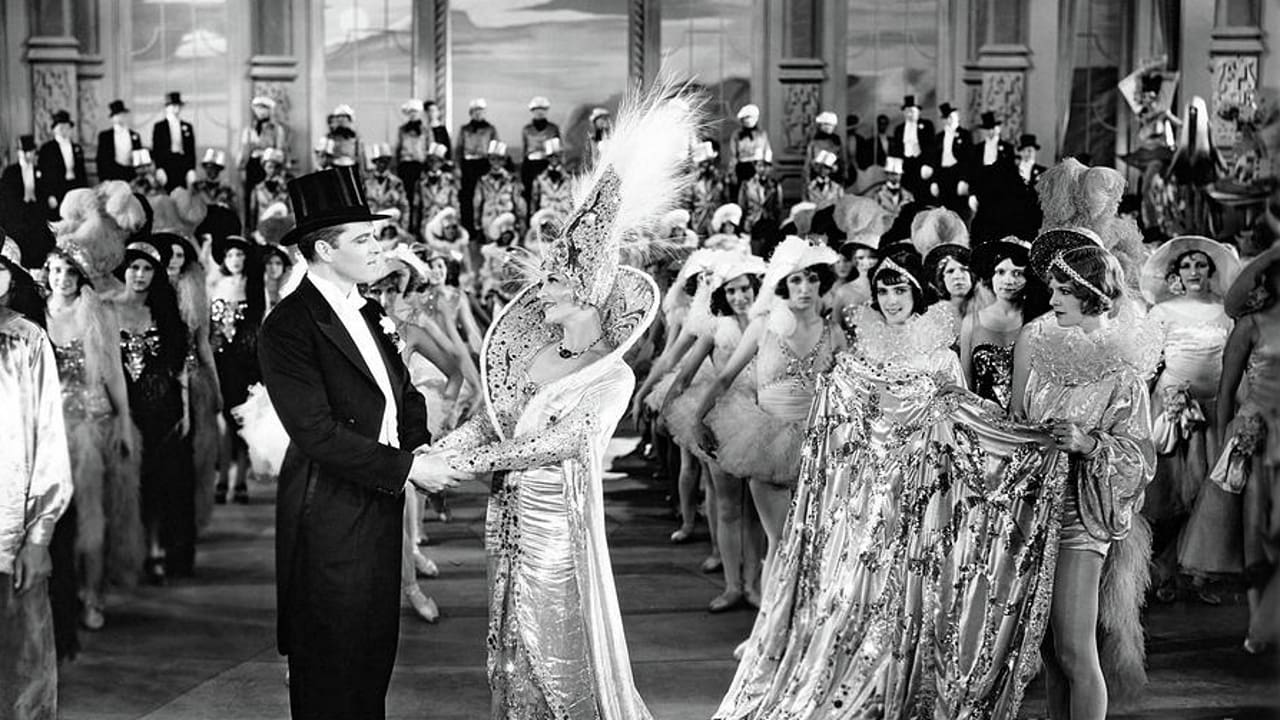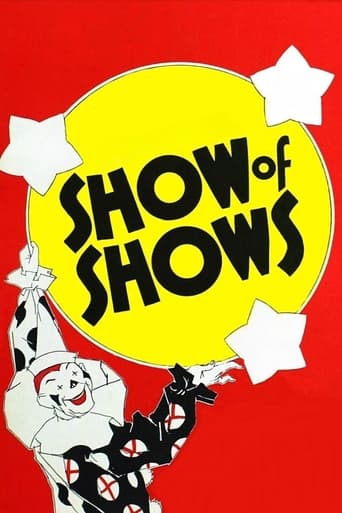



Very very predictable, including the post credit scene !!!
View MoreToo much about the plot just didn't add up, the writing was bad, some of the scenes were cringey and awkward,
View MoreTells a fascinating and unsettling true story, and does so well, without pretending to have all the answers.
View MoreOne of the worst ways to make a cult movie is to set out to make a cult movie.
View More"Show Of Shows" is one of those films that separate the men from the boys, so to speak. The casual viewers will probably abandon it within the first 5 minutes, leaving the hardcore buffs trying to spot some recognizable faces (just because these people were stars in 1929 does not automatically mean that they all had much of a film career later, even in the 1930s). To be fair, some of the formations in the gigantic dance numbers are architecturally stunning, a color sequence with a young Myrna Loy livens things up a little, and the film ends with about ten minutes of mighty impressive (and frenetic) dancing. But most of the comedy does not come across, most of the singing is indecipherable (perhaps due to the primitive 1929 sound technology), and some parts (especially the monologues) are simply unendurable. Still, I'm glad the film survives - it's history preserved. ** out of 4.
View MoreWouldn't it be nice to be able to peep through the (heavy) curtains of Time and physically drop into any previous year to properly sample the air, the people, the entertainment, the booze - or the lack of it. I'm afraid that's what we need to be able to do to fully understand this now, because watching often blurry incomprehensible 2D images through gauze requires some patience.It's 1929, Warner Brothers wanted to produce a revue talking picture starring most of its contracted players, a collection of comedy items, singing and dancing numbers linked by Frank Fay, who for the most part was rather Fey. The hodge-podge he introduced ranged from the sublime to the ridiculous, however all worthy of watching now to us archaeologists – when his turn eventually came to sing he was unsurprisingly cringeworthy too. There's almost endless impenetrable comic patter to get through but many good songs lie within, and for the most part with excellent orchestrations from Louis Silvers conducting the always sharp Vitaphone Orchestra. Winnie Lightner, fresh from Goldiggers Of Broadway belted out Ping Pongo and Singing In The Bathtub and these are definitely the highlights – she was allowed to be a highlight, sadly everyone else is shadowy and now of the shadows. The Technicolor section for Li-Po-Li sung by Nick Lucas and danced to by the not so inscrutable Myrna Loy was lost, found, restored – it's completely charming for the supposedly Oriental set as well as for the idiotic song lyrics. The big finale goes on for too long, but as with everything else in here is absolutely fascinating, even in the surviving black & white prints. John Barrymore played Richard III from a scene from Shakespeare's Henry VI, apparently this was well received in 1929 The film itself was not so well received in 1929 in that it only recovered less than twice its cost – it was expected to do better. It has me glued to the TV every time I put it on, but do you enjoy time travel as much as I do?
View MoreThe early all star musicals were designed to show audiences that even the most dramatic of stars could sparkle and captivate with their singing and dancing talent and also was a way to introduce new talent to an unknowing public ("if you like Irene Bordoni's song in "Show of Shows", you will just love her in her new movie "Paris"). They also served as screen tests where silent favourites were thrust in front of the cameras, often with no guidance or help (Clara Bow, who was a real hit in "Paramount on Parade" had to arrange her own hair), then struggled to entertain or wisecrack. Every studio had one in the pipeline, even lowly little Pathe, but they were the first type of musicals to find disfavour with the public. With the success of "The Hollywood Revue of 1929" Warner Bros. decided it, too, must have an all star revue but of the initial lineup only John Barrymore ended up in the movie. Al Jolson was a conspicuous no show, having demanded too much money (besides his last movie "Say It With Songs" was a huge flop). Master of Ceremonies was Frank Fay (at the time married to Barbara Stanwyck) a huge name in vaudeville but in movies his arrogance shone through. There is a running gag about him trying to convince the studio that he can sing - and three quarters of the way through he gets his chance but he has now picked up a side kick in Sid Silvers who does get to do an imitation of Al Jolson and a really awful song about bad breath (I'm not joking) called "If Your Best Friend Won't Tell You".Why, in my opinion, this revue fell flat, as opposed to "Paramount on Parade". Paramount knew the value of it's stars and each of it's numbers had the focus directed on one person (Clara Bow, Helen Kane, Nancy Carroll). "Show of Shows" seemed just a jumble of sketches designed to put as many of it's stars in as the stage would allow. That's why my favourite was Winnie Lightner. She had been a huge hit in "Gold Diggers of Broadway" and at the time probably seemed Warner's best bet for stardom (of course musicals were never going to go out of fashion were they?). She belted her way through "Pingo Pongo" and whether you liked that style or not she carried you through this zany song about cannibals, she looked like she was enjoying herself and actually loved to sing. She was back for another number, a funny parody of "Singin' in the Rain" called "Singin' in the Bathtub", performed in an over-sized bathroom with a male chorus dressed in old fashioned women's bathers. John Barrymore was also a standout and gave audiences a thrill with his Duke of Gloucester soliloquy from "Henry VI" and also a chance to see "the greatest Hamlet of his generation".A most bizarre opening - a nobleman is beheaded while a peasant shouts "On With the Show of Shows" - there follows an amazing precision military formation dance headed by Monte Blue. Next is the amusing "What Became of the Flora Dora Boys" (Myrna Loy, Sally O'Neil are among the girls , the boys are old comedians including Ben Turpin) which would have you believe that while the girls stayed young and beautiful, the boys hit hard times. There was a pirate number where Ted Lewis jazzed the blues away (was he really a popular band leader !!!) Richard Barthelemess introduced "Sisters" in which pairs of famous sisters (there were a few ring ins including Harriette Lake, soon to be Ann Sothern)did little dances in national costumes. I thought the problem with these numbers was even though the stars were introduced there was no individualizing - and it was often hard to pick out who was who. Just when you despaired, along came Rin Tin Tin who introduced "Li Po Li". It is the only Technicolor segment that has survived and it was dazzling - the turquoises, golds and reds were so sharp and striking. Myrna Loy is the Oriental dancing girl and Nick Lucas is the singer, there is a gigantic genie and chorus girls pop out of huge jars. It is all kitsch but wonderful.Irene Bordoni was just a bit too "different" - she sang sensuously "Just an Hour With You" but she was photographed too unflatteringly. Bea Lillie, to me, looked as though she could have been witty and funny in a modern way, was only given a few lines. Another skit in the "different" category - former middleweight fighter Georges Carpentier puts chorus girls through their exercising paces, finishing up climbing ladders where they do their formations on wall niches. The heavily promoted song of the show is "Lady Luck" and the finale, while long, is spectacular. Girls are revealed as human chandeliers as Alexander Gray tries to give the song ("don't give my hopes the razz") a touch of class. Then there come out every conceivable variety act - the floppy girl, the boy who can somersault one way and land the other and beautiful Armida who runs down the steps for a cute hip swinging dance."The Advent of a New Event in Pictures" was the slogan Warners used and at $800,000 it was their most expensive film (excepting "Noah's Ark"). It had everything, even a bathtub, but originality and proved that there was no place for revues as films it they didn't have style and class.
View MoreIt is difficult to evaluate this or any other comparable film of the early sound era in terms that one might use for ordinary film commentary. At times there is almost a desperation, as many film personalities of the silent era try their wings at sound, surely fearing that they will be left by the wayside (as did happen to some), Rin-Tin-Tin. however, was pertfectly natural. In such a vaudeville of unrelated sequences, some were sure to stand out John Barrymore's soliloquy from Richard II is a moment certainly worth preserving. By and large, only those with earlier stage training exuded confidence. However, this is over all reasonably entertaining, and a must for "film buffs" especially interested in the silent to sound transition
View More